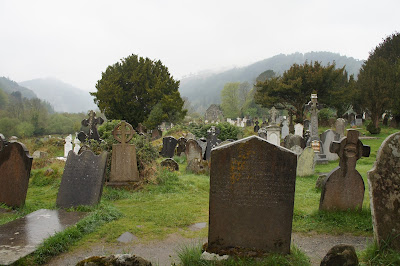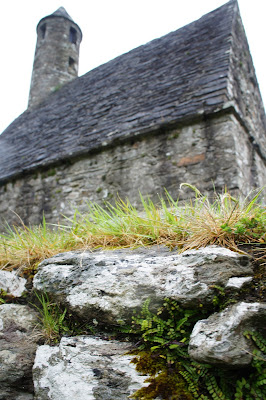Dublin Day 10: "I remember her! I touched her!"
Though it was a
misty day in Dublin, it provided the perfect backdrop to our trip to the
historic monastic complex at Glendalough in the nearby Wicklow Mountains. We
got to see the some of the remaining structures, an absolutely amazing
graveyard, and the two lakes that give Glendalough—“valley of two lakes”—it’s
name. It certainly lived up to my expectations. I had a great time today!
The coach set
off at 9AM like usual, bound for the Wicklow Mountains. These are the famed
hills from Braveheart, as well as
where Guinness is said to get the fresh water for its beer. As we drove up
through the winding roads and small towns, I could see why this landscape was
used for such a romantic film—especially today, when the whole road was filled
with rain and fog. I could tell we would have a good backdrop to visit the
monastery.
As we pulled up
to the visitor’s center after the hour and a half drive, everyone felt a little
bit queasy from the mountain roads. But we muscled through and went into the
center to learn a little bit about the background of the site. There was a
lovely little museum set up with a great diorama, which helped to illustrate
how the complex would have been laid out in its height. Because, as the museum
said, Glendalough was not a monastery as we would think of the word today. It
was more of a self-sustained community focused on religious worship and founded
by a religious man. There were gardens, many livestock pens, a cathedral, a
round tower, a graveyard, many smaller buildings on the outskirts, as well as
smaller inner buildings for things like cooking, individual worship, or
housing. Many ancient kings of Tara were known to visit, so they would have
stayed in the elaborate guesthouse inside the community.
Next, we watched
a short film on the monastery and got a quick introduction by a tour guide. The
movie had some interesting biases in it, which our professors commented on
later when we left. Part of the problem was that the film was narrated by a
stuck up British voice, which seemed out of place at an ancient Irish monastic
site.
And secondly, it
made it seem like Christianity somehow saved the entirety of pagan Ireland from
the “dark” things they worshipped before. Though St. Patrick is the patron
saint of Ireland and many people revere him for bringing Christianity, he did
not succeed in converting people like the film made it seem. He wasn’t really
saving them from anything, either. He simply asked the pagans if they wanted to
accept Jesus Christ and the Christian god and they said, “Sure, we’ll put him
on the alter with all of our other gods!” The conversion might have been
peaceful, but that is because no one really became a true Christian until later
generations. The beginning was just a fusion of two religions—a syncretic form
at its best. The film, in my opinion at least, did a very poor job of
explaining that delicate relationship.
The introduction
by our tour guide provided a lot more useful information about the site itself.
Glendalough means “valley of two lakes”. Appropriately, there are two lakes:
the Upper and the Lower. The monastic community was formed in the 6th
century by a man named St. Kevin. Kevin was a particularly fascinating
character in history because he grew up a descendent of a king. Despite his
bloodline, he decided to go found the community at Glendalough and secure a
small following of monks there with him. From there, he inspired more and more
followers to join him and also to establish similar monasteries all over
Ireland, the UK, and even the continent.
The site itself
has many unique and rare features. The double arch gateway would have once been
more ornate, but denotes the site as a monastery. All similar monasteries
around the country would have had that gated archway originally, though this
one is the only remaining example. Just inside the gate sits a large stone with
a cross carved into it. Apparently people would come from all over to enter the
monastery and touch the stone, because that would absolve all sins.
There is also a
fully intact round tower amidst the many graves in the churchyard—this is one
of only a few in Ireland that are still completely standing. The cathedral is
actually not too impressive anymore, since the roof is gone and not much of the
interior remains. However, the complete structure of St. Kevin’s church makes
up for that. The small church with a round spire and two rooms remains standing,
nestled just below the rest of the complex in its own little nook.
We also learned
a more appropriate analysis of the syncretic religion appearing in Ireland in
these medieval times. Our guide said that the popular Celtic cross—a cross with
a circle surrounding it—was actually a combination of the two religions’
symbols. The cross of Christianity was combined with the pagan circle, which
symbolized the sacred deities of the sun and the moon. The vast collection of
Celtic crosses scattered across the graveyard shows that this was probably a
great way to synthesize the two religions and achieve the “peaceful” rise of
Christianity that scholars are so quick to assume.
Walking through
the complex was absolutely worth the long bus ride. The mist framed the
buildings and the mountains just peaked out from behind the rain clouds to add
an ominous look to the place. As I walked through the massive graveyard, I
could feel the thin veil between the present and the past—I know it sounds
crazy, and I think the weather was egging me on. But I seriously felt that we
were not alone in that space. All of the history and the people buried in that
land were still around to protect it.
With that eerie
feeling, I happily walked through the rest of the yard to find the remains the
cathedral, a smaller ruined building almost lost amongst that graves, the
tower, and St. Kevin’s church. We came to the first river, where the path to
the lakes started. We decided to take the upper road, called the Green Road.
And it certainly was green! So many trees have begun to bloom in full force
now, as well as the moss and green grass that have been here the whole time. We
even spotted several huge slugs wandering around on the ground, out to enjoy
the damp weather.
After about a
ten minute walk, we arrived at the Lower Lake. This is a smaller, less
picturesque lake, but impressively beautiful nonetheless. Smaller mountains
frame it and a couple houses sit on its banks. We stopped for some pictures
before continuing on to the Upper Lake.
As soon as we got to the lake, we knew
it would be a special place. The whole area surrounding it was flat, filled
with green, and dotted with trees and flowering plants. The huge mountains went
straight up from the water, gathering mist at the tops. The water was as still
as glass and speckled with stones before becoming a complete mirror to what
stood above it. If we focused, we could see a waterfall sloping down at the
joint of the mountains in the very back of the lake. Like everything else at
Glendalough, it was almost surreally stunning.
We stayed there
for as long as we could, just taking in the peaceful company of the peaks and
the lake. Looking out into the landscape calmed my wound nerves enough to make
the long walk back to the bus a pleasant one. I took in everything I could,
because I knew that this trip in Ireland would be coming soon to an end. Seeing
incredible natural places like this remind me that my time here is running out.
I grabbed a few more pictures of the monastic site quickly before leaving the
thin veil of the past behind. How I would have liked to spend hours looking
around that graveyard, imaging a life for each of the names on those
gravestones. Sadly, however, the city called us back in a timely manner, and we
all boarded the bus to make the journey back.
The bus took a
different return route, this time past part of Dublin Bay and the Port of
Dublin. I appreciated this because I have not yet had time to walk over and see
the ocean here. Though the port is not necessarily the most picturesque,
especially on a foggy day like today, it was nice to see all of the boats lined
up in the blue-gray water. We then drove back along the Grand Canal past the 3
arena (the main sports facility in Dublin), the Convention Center, and the beautiful
Customs House. Though it was a long ride home, I think the whole day was such a
great introduction to the land outside the city. I wish I could have stayed
longer exploring the mountains in the misty weather.
The day was
pretty mundane from then on—the standard Week 10 homework party, and catching
up on photos and reading. We needed to get some rest both after Norway and in preparation
for our visit to the zoo tomorrow. We get to go learn about Asian elephants at
the Dublin Zoo and maybe—maybe—get to interact with them a little bit. I am not
aiming too high, but it would be really amazing to see the training or feeding
behind the scenes in addition to an educational lecture. I can’t wait to also
have my first visit to the zoo!
♥
photo credit Katie Walker













































































No comments:
Post a Comment